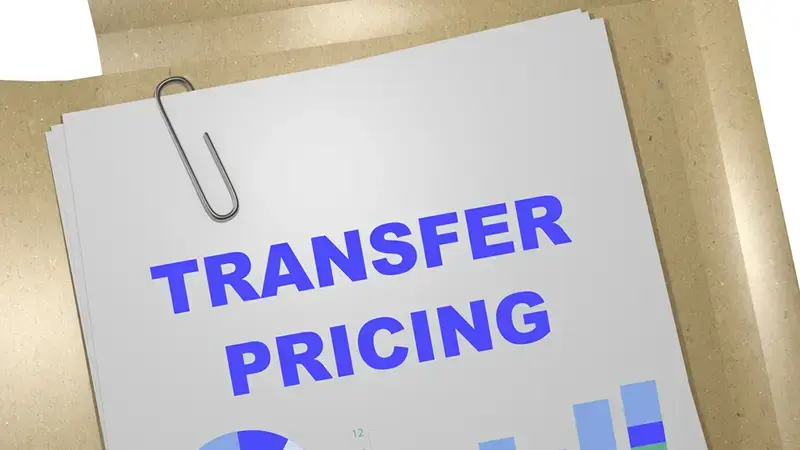Transfer Pricing Documentation: A Comprehensive Guide
In today’s global economy, transfer pricing documentation is essential for multinationals to comply with international tax laws and mitigate legal...
10 min read
 H&CO
Dec 20, 2024 8:56:23 AM
H&CO
Dec 20, 2024 8:56:23 AM

For multinational corporations, navigating global tax compliance is like walking through a minefield of regulations and political challenges—where transfer pricing disputes often become unavoidable. When these disputes arise, companies can find themselves in a fiscal nightmare, facing the daunting combination of double taxation, relentless scrutiny from regulatory bodies, and strained interactions with tax authorities. This trifecta can erode profits and disrupt daily operations. Are you concerned about transfer pricing disputes jeopardizing your business? Think of effective risk management as your safety net, helping you anticipate challenges and maintain stability amidst uncertainty.
Minimizing risk is a game-changer for companies, and tools like Advance Pricing Agreements (APAs) and Mutual Agreement Procedures (MAPs) are the championship plays—delivering victory every time. When expert insights, precise documentation, and cutting-edge technology come together, tax complexities fade into the background, empowering you to navigate even the most challenging terrains with confidence.
| Key Takeaways |
|
CONTENT INDEX
Transfer pricing disputes arise when there are disagreements between tax authorities and businesses over the pricing of intra-group transactions between related parties. Prices charged in intercompany transactions should align with those that would occur between unrelated parties under the same circumstances, ensuring that the results are consistent with what would have occurred if unrelated parties had engaged in the same transaction under identical circumstances, emphasizing compliance with international tax laws and ensuring fair market value.
Advance Pricing Agreements (APAs) are proactive arrangements between taxpayers and tax authorities to establish pre-determined transfer pricing methods for specific intercompany transactions. These agreements aim to provide certainty and transparency in transfer pricing, reducing the risk of disputes and double taxation.
Unilateral APAs involve an agreement between a single taxpayer and one tax authority. While this type provides straightforward compliance, it doesn’t consider the international implications of cross-border transactions.
Bilateral and multilateral APAs, on the other hand, involve agreements between two or more tax authorities and the taxpayer. Bilateral APAs are particularly common, often facilitated by tax treaties, with nearly 70% of agreements negotiated with the IRS being classified as bilateral since the program’s inception.
Multilateral APAs, involving multiple tax authorities worldwide, are even more comprehensive, ensuring compliance across several jurisdictions.
Securing an APA involves several key steps. The process typically begins with pre-filing consultations between the taxpayer and the tax authorities. This initial stage allows both parties to discuss the potential APA and clarify any preliminary issues. With their preparations in place, the taxpayer submits a formal proposal detailing their approach to transaction rules, pricing strategies, and meeting tax compliance obligations.
After submitting the formal request, both parties negotiate to finalize the agreement’s terms under the same circumstances that would occur between unrelated parties. The fate of your transaction pricing hangs in the balance, so consider this a critical crossroads – get it wrong, and you'll be feeling the effects later on.

Mutual Agreement Procedures (MAPs) are mechanisms embedded within income tax treaties designed to resolve conflicts between tax authorities of different nations concerning transfer pricing and to prevent tax avoidance. Smoothly resolving cross-border taxation disputes is the goal, and these procedures make it happen by adhering to treaty guidelines.
When tax disputes or cross-border tax snags arise, MAPs jump into action, outlining a strategy that keeps you protected, approved, and within the bounds of global tax legislation.
The MAP process begins with a taxpayer’s request to resolve adjustments proposed by U.S. or foreign tax authorities. A successful submission hinges on presenting a clear, concise summary of the dispute, supported by solid evidence to highlight the core issue. By cutting through the noise, this approach ensures tax authorities can focus on the dispute with clarity and efficiency, paving the way for meaningful resolution. Adhering to prescribed timelines and protocols is critical, as it simplifies the process and facilitates cooperation between jurisdictions for smooth conflict resolution.
Mutual Agreement Procedures (MAPs) are a powerful tool for reducing the risk of double taxation, a frequent challenge for businesses operating across multiple jurisdictions. By enabling jurisdictions to collaboratively resolve disputes, MAPs deliver a single, definitive outcome, eliminating uncertainty. For taxpayers stuck in protracted legal disputes, MAPs provide a structured and efficient resolution pathway, ensuring compliance and reducing the chance of future conflicts.
Proper documentation is the backbone of transfer pricing compliance, especially for services exchanged internationally. Imagine transferring millions across borders, only to be flagged by regulatory bodies - that’s a headache you can avoid with proper documentation.
To stay on the right side of transfer pricing regulations, companies need to get their documentation in order, covering all the necessary bases. Solid document management and best practices go hand-in-hand - one isn’t effective without the other.
Essential documents for tax compliance and transfer pricing compliance include intercompany agreements, financial statements, and pricing policies. Compliance with these agreements is vital - one misstep can bring unwelcome attention during an audit. Documents supporting transfer pricing assertions should include internal communications to strengthen the compliance argument.
The government of one country would ask you to leave all the taxable income in their country while the other involved country would ask for the same. It is through documentation that you can justify intercompany transactions involving shifting of income through related party transactions. The documentation must show that you are charging the same gross profit percentage for related party transactions as you are charging for unrelated parties.
Adopting a flexible documentation approach anticipates local requirements and adjusts to varying levels of regulatory scrutiny, including tax audits. With cloud-based platforms at their fingertips, teams experience unparalleled collaboration, rapidly processing transfer pricing calculations and generating accurate documentation on the fly.
Handshakes may fall through, but arbitration grasps the nettle of tenacious transfer pricing and tax disagreements, letting neither side fall short of resolution. Having a clear arbitration clause in intercompany agreements is like having a haven - it provides a reliable framework for resolving disputes and protecting business interests. By relying on arbitration, disputes get settled faster, legal bills shrink, and confidentiality is maintained. However, drawbacks include limited discovery and binding decisions, leaving no room for appeal.
An effective arbitration clause should clearly outline the scope of disputes, the arbitration process, and the governing law. Clear terms in arbitration clauses safeguard business interests during transfer pricing disputes with tax authorities. Including provisions for selecting arbitrators and specifying the arbitration venue in the agreement is crucial. Because arbitration is only as good as its transparency and fairness, we make sure these values drive every aspect of our process.
Going the arbitration route promises both sides a degree of anonymity, dispensing with the worry of prying eyes; as a result, the two parties can hammer out a tax compliance plan with unguarded candor. Arbitrators' decisions often have the final say, leaving little wiggle room for reversals or exceptions. This can be a disadvantage if the arbitrator does not fully understand the complex issues in transfer pricing disputes.
Handshakes may fall through, but arbitration grasps the nettle of tenacious transfer pricing and tax disagreements, letting neither side fall short of resolution. By relying on arbitration, disputes get settled faster, legal bills shrink, and confidentiality is maintained.
Engaging expert advisors is crucial for navigating complex tax regulations and transfer pricing disputes and ensuring compliance. Precise approaches developed in conjunction with expert advisors resolve business conflicts swiftly and decisively, safeguarding your interests.
Whether you're caught up in a protracted dispute or struggling to make sense of ever-shifting regulations, experts in auditing firms and transfer pricing are invaluable allies, able to clarify the issues and map out a clear path forward.
Collaboration with tax professionals ensures compliance with varying transfer pricing regulations across jurisdictions. Think of a transfer pricing advisor as a trusted guide - you want someone who's been around the block, with a deep understanding of your industry and a track record of success in cases similar to yours.
Background A multinational technology company operating in North America and Europe faced a transfer pricing audit from a European tax authority. Two parties found themselves at odds over the dollars and cents of software licensing agreements between sister companies, with the tax authority crying foul and insisting these rates needed to match those of similar transactions between unrelated companies. A weighty double taxation hurdle looms large for the company, courtesy of the authority's recommended tweaks, and its bottom line is set to take a nasty tumble.
Challenge - it's a barrier to entry, a hurdle that requires unwavering determination to clear, and a test of character that separates winners from quitters. What we must do is persuasively demonstrate to stakeholders that our intercompany pricing is consonant with the principles outlined in OECD guidelines and reinforced by local regulations. A nagging dispute was on the cusp of spinning out of control, bringing with it the pricey specter of lawyers' fees and the very real danger of brand damage.
Audit Defense and Negotiation Our transfer pricing experts conducted a detailed review of the company’s documentation and financial models. Faced with shortcomings in the company's analysis, they responded with a barrage of fresh economic data, shoring up their arm's length defense in the process.
Engaging in a Mutual Agreement Procedure (MAP) To avoid double taxation, We initiated a Mutual Agreement Procedure (MAP) between the tax authorities in Europe and North America. Collaboration pays, and for jurisdictions, it meant reducing the risk of penalties, thereby unshackling resources that could be better spent on more pressing concerns.
Enhancing Documentation The team prepared supplemental documentation, including a revised transfer pricing study and detailed functional analysis, to address specific concerns raised by the tax authority.
Arbitration Support In parallel, we worked with legal counsel to prepare for potential arbitration, ensuring that the company was fully equipped if the dispute required escalation.
Outcome Through strategic negotiations and a robust defense, we successfully resolved the dispute during the MAP process. Double taxation no longer loomed large, thanks to the pared-down adjustments made by the European tax authority – a considerable boon to the company's fiscal well-being. A fortified foundation: that's what the company got when it rolled out improved documentation and policies, making it better prepared to handle disputes down the road.
Technology can enhance financial reporting and ensure compliance, especially in multi-entity firms where accurate reporting is crucial. With cutting-edge tech at our fingertips, we can finally breathe a sigh of relief - goodbye mistakes, hello clarity!
Just one mismatched price can ripple across an entire organization, causing trouble down the line. However advanced software can step in to safeguard your transfer pricing strategy, keeping you in line with regulatory expectations.
A company's pricing strategy thrives on current, reliable data, turning insights into tangible results while safeguarding against surprises from the taxman through proactive compliance management. Leveraging data analytics allows businesses to monitor transfer pricing strategies in real time, uncover transaction patterns, and identify anomalies, ensuring readiness for audits and compliance challenges.

Preparing for transfer pricing audits involves thorough risk assessment to ensure tax compliance and reduce audit risks. Proper documentation for intercompany transactions serves as the first line of defense against challenges to transfer pricing practices.
A pre-audit review is like a reality check, allowing you to identify and fix weaknesses before they lead to trouble. Voluntary disclosures to tax authorities can lead to favorable outcomes if discrepancies are found during pre-audit reviews.
Understand the Audit Scope: Confirm jurisdictions, transactions, and periods under review.
Review Transfer Pricing Policy: Ensure alignment with regulations and actual business practices.
Document Organizational Structure: Map ownership, entity roles, and intercompany relationships.
Conduct Functional Analysis: Define the functions, risks, and assets of each entity.
List Intercompany Transactions: Identify and document all controlled transactions.
Verify Intercompany Agreements: Confirm agreements are current and consistent with pricing policies.
Compile Compliance Documentation: Gather master file, local file, and benchmarking studies.
Review Financial Statements: Ensure entity profitability aligns with their functions and risks.
Validate Benchmarking Comparable: Confirm comparables and methods are appropriate for the period.
Assess Tax Risks and Disputes: Review prior audits and jurisdictions with high audit risks.
Ensure Consistency in Operations: Reconcile transactions with policies and documentation.
Review Local Regulations: Verify compliance with local and international transfer pricing laws.
Engage Key Personnel and Advisors: Coordinate internal teams and external advisors for audit readiness.
Conduct a Mock Audit: Simulate audit queries and evaluate response effectiveness.
Prepare Documentation for Submission: Organize, index, and redact sensitive information.
Plan Audit Logistics: Assign roles, and responsibilities, and schedule internal reviews. By following this checklist, you can minimize risks, address potential red flags, and demonstrate compliance with transfer pricing regulations to the tax authorities.
Taxpayers should be ready to explain why certain methods were chosen over others in their transfer pricing documentation. In the face of increasingly complex international tax laws, businesses can't afford to wing it when it comes to transfer pricing disputes - a well-planned approach is essential to stay compliant. Proactive movers use fee-based arrangements and tech-facilitated audit resolves to minimize blowback.
At H&CO, we are dedicated to delivering customized transfer pricing solutions that align with your business’s global objectives while ensuring compliance with local and international tax regulations. Safeguarding your business from troublesome audits and monetary penalties is what drives us to meticulously prepare top-notch Master and Local Files, offering total documentation clarity and providing you with complete peace of mind.
How to create top-notch documentation that is watertight and error-proof? That's our specialty. We have a global team that creates custom reports designed to protect your company from reputational risks and keep you compliant with tax regulations around the world.
We have over 30 years of working in international taxation offering individual tax services, corporate taxes, and expat tax services.
Here is a comprehensive list of Transfer Pricing Services offered:
Transfer Pricing Documentation
Transfer Pricing Benchmark Study & Analysis
Operational Transfer Pricing
Transfer Pricing Risk Identification & Assessment
Value Chain Analysis
Transfer Pricing Dispute Resolution
Transfer Pricing Policy Design
Audit and Compliance Support
Global Transfer Pricing Compliance Monitoring
Intercompany Agreement Review and Drafting
Our goal is to provide tailored transfer pricing solutions that help you achieve compliance and operational efficiency while supporting your global expansion strategies.
Transfer pricing disputes often boil down to a failure to prep credible justifications for deals or unseating differences of opinion over what the tax laws mean – and audits are the catalyst that sets it all in motion. Anticipating and addressing these issues puts you in control, and lets you sidestep potential roadblocks down the line. Inconsistencies in pricing for the same transaction can lead to disputes, emphasizing the importance of maintaining consistency in pricing between affiliates.
Picture this: taxpayers and tax authorities from different jurisdictions sitting down together, agreeing on a clear set of criteria for certain transactions - this is what an Advance Pricing Agreement is all about, reducing transfer pricing disputes. Clear-cut rules mean that tax compliance is now more straightforward and accountable.
When taxpayers lodge a dispute request, they kick off the Mutual Agreement Procedure (MAP), handing over a mound of documentation that spells out the problem. This allows tax officials to put their collective heads together and hash out a mutual resolution. Cross-border tax headaches don't have to create a bottleneck for your company; finding the right solutions is what matters.
Employing arbitration clauses can be just the ticket. Arbitration clauses in tax disputes and transfer pricing disputes offer quick resolution, reduced legal costs, and confidentiality.

In today’s global economy, transfer pricing documentation is essential for multinationals to comply with international tax laws and mitigate legal...

Operational transfer pricing is a cornerstone for ensuring compliance, fairness, and efficiency in intercompany transactions for goods and services...

Expanding globally offers immense opportunities but also introduces significant transfer pricing risks for multinational corporations that can...